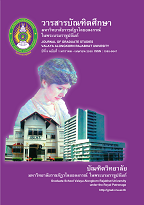การพัฒนารูปแบบการสอนอ่านภาษาอังกฤษเพื่อความเข้าใจ สำหรับนักเรียนระดับมัธยมศึกษาตอนต้น THE DEVELOPMENT OF AN ENGLISH READING COMPREHENSION INSTRUCTIONAL MODEL FOR LOWER SECOND SCHOOL STUDENTS
Main Article Content
Abstract
บทคัดย่อ
การวิจัยครั้งนี้มีวัตถุประสงค์เพื่อ 1) ศึกษาข้อมูลพื้นฐานสำหรับการพัฒนารูปแบบการสอน วิเคราะห์องค์ประกอบเชิงยืนยันของความสามารถในการอ่านภาษาอังกฤษเพื่อความเข้าใจ และศึกษาและพัฒนารูปแบบปัจจัยเชิงสาเหตุที่ส่งผลต่อความสามารถในการอ่านภาษาอังกฤษเพื่อความเข้าใจ 2) สร้างและตรวจสอบคุณภาพของรูปแบบการสอน 3) ทดลองใช้และศึกษาผลการใช้รูปแบบการสอน และ 4) ศึกษาความพึงพอใจของนักเรียนที่มีต่อการจัดการเรียนรู้โดยใช้รูปแบบการสอน การดำเนินการวิจัยแบ่งออกเป็น 4 ระยะ ได้แก่ ระยะที่ 1 เป็นการศึกษาข้อมูลพื้นฐานสำหรับ การพัฒนารูปแบบการสอน วิเคราะห์องค์ประกอบเชิงยืนยันของความสามารถในการอ่านภาษาอังกฤษเพื่อความเข้าใจ และศึกษาและพัฒนารูปแบบปัจจัยเชิงสาเหตุที่ส่งผลต่อความสามารถในการอ่านภาษาอังกฤษเพื่อความเข้าใจ ระยะที่ 2 เป็นการสร้างและตรวจสอบคุณภาพของรูปแบบการสอนและเอกสารประกอบรูปแบบการสอน และทดลองนำร่องใช้เพื่อศึกษาความเป็นไปได้ใน เชิงปฏิบัติ ระยะที่ 3 เป็นการทดลองใช้และศึกษาผลการใช้รูปแบบการสอน และระยะที่ 4 เป็น การประเมินความพึงพอใจของนักเรียนที่มีต่อการจัดการเรียนรู้โดยใช้รูปแบบการสอนอ่านภาษาอังกฤษเพื่อความเข้าใจ
ผลการวิจัยพบว่า
1. ผลการศึกษาข้อมูลพื้นฐาน พบว่า ข้อมูลพื้นฐานสำหรับการพัฒนารูปแบบการสอน ประกอบด้วยเอกสารเกี่ยวกับรูปแบบการสอน หลักสูตร การอ่านและการสอนอ่าน และทฤษฎี การเรียนรู้ ผลการวิเคราะห์องค์ประกอบเชิงยืนยัน พบว่า ความสามารถในการอ่านภาษาอังกฤษ เพื่อความเข้าใจประกอบด้วย 3 องค์ประกอบ ได้แก่ องค์ประกอบที่ 1 ด้านความเข้าใจระดับตัวอักษร มี 7 ตัวบ่งชี้ องค์ประกอบที่ 2 ด้านความเข้าใจระดับตีความ มี 9 ตัวบ่งชี้ และองค์ประกอบที่ 3 ด้านความเข้าใจระดับวิเคราะห์วิจารณ์ มี 7 ตัวบ่งชี้ และผลการศึกษาปัจจัยเชิงสาเหตุ พบว่า ปัจจัย เชิงสาเหตุที่ส่งผลต่อความสามารถในการอ่านภาษาอังกฤษเพื่อความเข้าใจ ประกอบด้วย 10 ตัวแปร โดยตัวแปรที่ส่งผลทางตรงอย่างเดียว ได้แก่ ความตั้งใจเรียน และความรู้พื้นฐานเดิม ตัวแปรที่ส่งผลทางตรงและทางอ้อม ได้แก่ ความถนัดทางภาษา และตัวแปรที่ส่งผลทางอ้อมอย่างเดียว ได้แก่ ปฏิสัมพันธ์ระหว่างนักเรียนกับนักเรียน คุณภาพการสอนของครู ความเอาใจใส่ของผู้ปกครอง แรงจูงใจใฝ่สัมฤทธิ์ และอัตมโนทัศน์เกี่ยวกับตนเอง
2. ผลการสร้างและตรวจสอบคุณภาพของรูปแบบการสอน พบว่า รูปแบบการสอนที่พัฒนาขึ้น คือ รูปแบบการสอนอ่านภาษาอังกฤษเพื่อความเข้าใจสำหรับนักเรียนระดับมัธยมศึกษาตอนต้น ซึ่งมีองค์ประกอบ 5 องค์ประกอบ ได้แก่ หลักการ จุดมุ่งหมาย เนื้อหา กระบวนการเรียนการสอน และการวัดและประเมินผล โดยกระบวนการเรียนการสอนมี 3 ขั้นตอน ได้แก่ 1) ขั้นก่อนอ่าน ประกอบด้วย 1.1) ขั้นกระตุ้นและสร้างแรงจูงใจ 1.2) ขั้นพัฒนาความรู้พื้นฐาน 1.3) ขั้นวางแผน การอ่าน 2) ขั้นระหว่างอ่าน ประกอบด้วย 2.1) ขั้นทำความเข้าใจบทอ่าน 2.2) ขั้นอภิปรายแลกเปลี่ยน และ 3) ขั้นหลังอ่าน ประกอบด้วย 3.1) ขั้นนำเสนอผลการอ่าน 3.2) ขั้นเสริมทักษะ การอ่าน และ 3.3) ขั้นประเมินผลและแก้ไข ผลการตรวจสอบคุณภาพของรูปแบบการสอน พบว่า รูปแบบการสอนมีคุณภาพอยู่ในระดับดี และผลการทดลองนำร่องใช้เพื่อศึกษาความเป็นไปได้ใน เชิงปฏิบัติ พบว่ากระบวนการเรียนการสอนสามารถดำเนินการได้อย่างต่อเนื่อง
3. ผลการทดลองใช้และศึกษาผลการใช้รูปแบบการสอน พบว่า นักเรียนมีพัฒนาการ ด้านความสามารถในการอ่านภาษาอังกฤษเพื่อความเข้าใจสูงขึ้นอย่างมีนัยสำคัญทางสถิติที่ระดับ .05
4. ผลการประเมินความพึงพอใจของนักเรียนที่มีต่อการจัดการเรียนรู้โดยใช้รูปแบบการสอน พบว่า นักเรียนมีความพึงพอใจต่อการจัดการเรียนรู้โดยใช้รูปแบบการการสอนอยู่ในระดับมาก
ABSTRACT
The purposes of this research were 1) to study basic information for the development of the instructional model, to perform a confirmatory factor analysis of English reading comprehension ability and to study and develop a model of causal factors influencing English reading comprehension ability 2) to develop and assess the quality of the instructional model 3) to try out and examine the results of using the instructional model and 4) to study the students’ satisfaction towards learning management by using the instructional model. The research procedures comprised 4 phases. First, basic information for the development of the instructional model and a confirmatory factor analysis of English reading comprehension ability were investigated. Second, the instructional model and materials were developed and checked and then a pilot study was conducted. Third, the instructional model was tried out. Fourth, students’ satisfaction towards learning management by using the instructional model was studied.
The findings of the research revealed that:
1. The result of study on basic information founded that basic information for the development of the instructional model consisted of concepts about instructional model, curriculum, reading and teaching reading and learning theories. The result of confirmatory factor analysis founded that English reading comprehension ability consisted of 3 components: 1) the first component was literal comprehension including 7 indicators 2) the second component was interpretative comprehension including 9 indicators and 3) the third component was critical comprehension including 7 indicators. At last, causal factors influencing English reading comprehension ability consisted of 10 factors. The result showed that the factors only directly influencing English reading comprehension ability comprised paying attention to learning and prior knowledge. The factors both directly and indirectly influencing English reading comprehension ability comprised language aptitude. The factors only indirectly influencing English reading comprehension ability comprised student-to-student interaction, teacher’s teaching quality, parents’ care, achievement motivation, and self-concept.
2. The result of the development of the instructional model founded that instructional model consisted of 5 major components; principle, objective, contents, instructional procedures and measurement and evaluation. The instructional procedures comprised 3 stages: 1) pre-reading stages consisted of 1.1) activating and motivating 1.2) developing background knowledge 1.3) planning for reading 2) while-reading stages consisted of 2.1) understanding the text 2.2) discussing and sharing and 3) post-reading stage consisted of 3.1) presenting 3.2) reinforcing and 3.3) checking and correcting. The quality of the instructional model was at the good level. Additionally, the result of a pilot study showed that instructional procedures of the developed model were consistent.
3. The result of using the instructional model founded that the developed instructional model could increase the English reading comprehension ability at statistically significant level of .05.
4. The result of study on students’ satisfaction towards learning management by using the instructional model founded that the students’ satisfaction towards learning management by using the instructional model was at the high level.
Article Details

This work is licensed under a Creative Commons Attribution-NonCommercial-NoDerivatives 4.0 International License.
บทความทุกเรื่องได้รับการตรวจความถูกต้องทางวิชาการโดยผู้ทรงคุณวุฒิ ทรรศนะและข้อคิดเห็นในบทความ Journal of Global of Perspectives in Humanities and Social Sciences (J-GPHSS) มิใช่เป็นทรรศนะและความคิดของผู้จัดทำจึงมิใช่ความรับผิดชอบของบัณฑิตวิทยาลัย มหาวิทยาลัยราชภัฏวไลยอลงกรณ์ ในพระบรมราชูปถัมภ์ กองบรรณาธิการไม่สงวนสิทธิ์การคัดลอก แต่ให้อ้างอิงแหล่งที่มา


